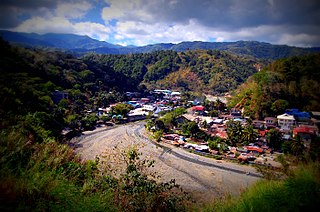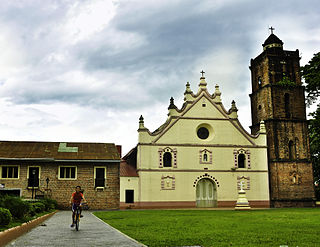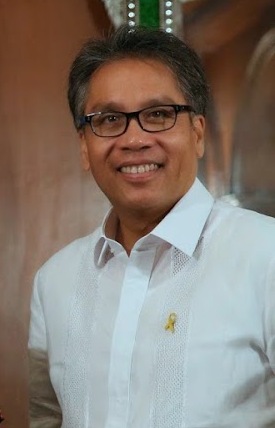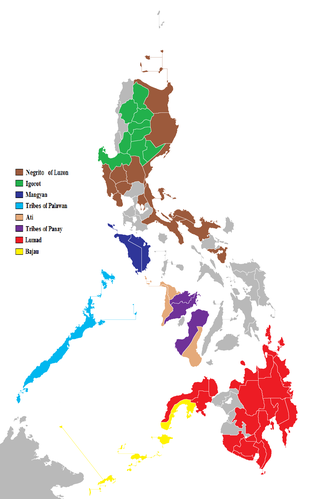
In the Philippines, provinces are one of its primary political and administrative divisions. There are 82 provinces at present, which are further subdivided into component cities and municipalities. The local government units in the National Capital Region, as well as independent cities, are independent of any provincial government. Each province is governed by an elected legislature called the Sangguniang Panlalawigan and an elected governor.

Cagayan Valley, designated as Region II, is an administrative region in the Philippines. Located in the northeastern section of Luzon, it is composed of five Philippine provinces: Batanes, Cagayan, Isabela, Nueva Vizcaya, and Quirino. The region hosts four chartered cities: Cauayan, Ilagan, Santiago, and Tuguegarao.

Nueva Vizcaya, officially the Province of Nueva Vizcaya, is a landlocked province in the Philippines located in the Cagayan Valley region in Luzon. Its capital is Bayombong. It is bordered by Benguet to the west, Ifugao to the north, Isabela to the northeast, Quirino to the east, Aurora to the southeast, Nueva Ecija to the south, and Pangasinan to the southwest. Quirino province was created from Nueva Vizcaya in 1966.

Davao Oriental, officially the Province of Davao Oriental, is a province in the Philippines located in the Davao Region in Mindanao. Its capital is the city of Mati, and it borders the province of Davao de Oro to the west, and Agusan del Sur and Surigao del Sur to the north. The province is the traditional homeland of the Mandaya and Kalagan/Kaagan.

The Cordillera Administrative Region, also known as the Cordillera Region and Cordillera, is an administrative region in the Philippines, situated within the island of Luzon. It is the only landlocked region in the insular country, bordered by the Ilocos Region to the west and southwest, and by the Cagayan Valley Region to the north, east, and southeast. It is the least populous region in the Philippines, with a population less than that of the city of Manila.

The Ilocos Region, designated as Region I, is an administrative region of the Philippines. Located in the northwestern section of Luzon, it is bordered by the Cordillera Administrative Region to the east, the Cagayan Valley to the northeast and southeast, Central Luzon to the south, and the South China Sea to the west.

The indigenous peoples of the Cordillera in northern Luzon, Philippines, often referred to by the exonym Igorot people, or more recently, as the Cordilleran peoples, are an ethnic group composed of nine main ethnolinguistic groups whose domains are in the Cordillera Mountain Range, altogether numbering about 1.8 million people in the early 21st century.

San Juan, officially the Municipality of San Juan, is a 2nd class municipality in the province of La Union, Philippines. According to the 2020 census, it has a population of 40,507 people.

Dupax del Sur, officially the Municipality of Dupax del Sur, is a 2nd class municipality in the province of Nueva Vizcaya, Philippines. At the 2020 census, it had a population of 21,224 people.

Santa Fe, officially the Municipality of Santa Fe, is a 3rd class, landlocked municipality in the province of Nueva Vizcaya, Philippines. According to the 2020 census, it has a population of 18,276 people.

Villaverde, officially the Municipality of Villaverde, also spelled as Villa Verde, is a 5th class municipality in the province of Nueva Vizcaya, Philippines. According to the 2020 census, it has a population of 20,118 people.

Manuel "Mar" Araneta Roxas II is a Filipino politician who served as a Senator of the Philippines. He is the grandson and namesake of former Philippine President Manuel Roxas. He served in the Cabinet of the Philippines as Secretary of the Interior and Local Government from 2012 to 2015. Previously, he was the Secretary of Trade and Industry from 2000 to 2003 and Secretary of Transportation and Communications from 2011 to 2012. He is the son of former Senator Gerry Roxas.

The Pan-Philippine Highway, also known as the Maharlika Highway, is a network of roads, expressways, bridges, and ferry services that connect the islands of Luzon, Samar, Leyte, and Mindanao in the Philippines, serving as the country's principal transport backbone. Measuring 3,379.73 kilometers (2,100.07 mi) long excluding sea routes not counted by highway milestones, it is the longest road in the Philippines that forms the country's north–south backbone component of National Route 1 (N1) of the Philippine highway network. The entire highway is designated as Asian Highway 26 (AH26) of the Asian Highway Network.

Philippine Rice Research Institute (PhilRice) is a government corporate entity attached to the Department of Agriculture created through Executive Order 1061 on November 5, 1985 to help develop high-yielding and cost-reducing technologies for farmers.

The 2007 Philippine House of Representatives elections were held on May 14, 2007, to elect members to the House of Representatives of the Philippines to serve in the 14th Congress of the Philippines from June 30, 2007, until June 30, 2010. The Philippines uses parallel voting for seats in the House of Representatives.

The following outline is provided as an overview of and topical guide to the Philippines:

The indigenous peoples of the Philippines are ethnolinguistic groups or subgroups that maintain partial isolation or independence throughout the colonial era, and have retained much of their traditional pre-colonial culture and practices.
Micro businesses in the Philippines can be defined according to the size of assets, size of equity capital, and number of employees. A typical micro business is a business that employs nine people or fewer, with assets of ₱3 million and below.
The chocolate industry in the Philippines developed after introducing the cocoa tree into Philippine agriculture. The growing of cacao or cocoa boasts a long history stretching from the colonial times. Originating from Mesoamerican forests, cacao was first introduced by the Spanish colonizers four centuries ago. Since then the Philippine cocoa industry has been the primary producer of cocoa beans in Southeast Asia. There are many areas of production of cacao in the Philippines, owing to soil and climate. The chocolate industry is currently on a small to medium scale.
















